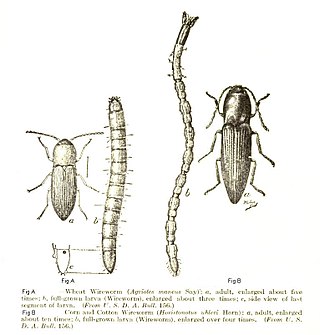
Elateridae or click beetles are a family of beetles. Other names include elaters, snapping beetles, spring beetles or skipjacks. This family was defined by William Elford Leach (1790–1836) in 1815. They are a cosmopolitan beetle family characterized by the unusual click mechanism they possess. There are a few other families of Elateroidea in which a few members have the same mechanism, but most elaterid subfamilies can click. A spine on the prosternum can be snapped into a corresponding notch on the mesosternum, producing a violent "click" that can bounce the beetle into the air. Clicking is mainly used to avoid predation, although it is also useful when the beetle is on its back and needs to right itself. There are about 9300 known species worldwide, and 965 valid species in North America.
Glowworm or glow-worm is the common name for various groups of insect larvae and adult larviform females that glow through bioluminescence. They include the European common glow-worm and other members of the Lampyridae, but bioluminescence also occurs in the families Elateridae, Phengodidae and Rhagophthalmidae among beetles; as well as members of the genera Arachnocampa, Keroplatus and Orfelia among keroplatid fungus gnats.

The Elateroidea are a large superfamily of beetles. It contains the familiar click beetles, fireflies, and soldier beetles and their relatives. It consists of about 25,000 species.

Sphaerocarpaceae is a family of liverworts known as bottle liverworts. Approximately ten species are included in this family, most of them in the genus Sphaerocarpos, but one additional species in the genus Geothallus.

Megapenthes lugens is a species of primarily European click beetle. The adult is black, narrow and 7–10 mm (0.28–0.39 in) long. The larvae feed on weevil larvae in the decaying trunks of beech and elm. In July 2010, the common name "queen's executioner beetle" was proposed following a competition.

Agapostemon texanus is a species of bee found in North America. Commonly known as the metallic green sweat bee or the Texas striped sweat bee, it varies greatly in its appearance, with variations in color and in the amount of black markings on the legs.
The Coffin Cave mold beetle, also known as the Inner Space Caverns mold beetle, is a small insect that is only found in caves. They are very small at 2.60–2.88 mm (0.102–0.113 in) and lack any form of eyes. They are found exclusively in caves in a single county in Texas, Williamson County. The United States Fish and Wildlife Service considers the Coffin Cave mold beetle to be an endangered species. Threats facing this species include urbanization.

Dyspanopeus sayi is a species of mud crab that is native to the Atlantic coast of North America. It has also become established outside its native range, living in Swansea Docks since 1960, the Mediterranean Sea since the 1970s, the North Sea since 2007 and the Black Sea since 2010. It can reach a carapace width of 20 mm (0.8 in), and has black tips to its unequal claws. It feeds on bivalves and barnacles, and is in turn eaten by predators including the Atlantic blue crab, Callinectes sapidus. Eggs are produced from spring to autumn, the offspring reach sexual maturity the following summer, and individuals can live for up to two years. The closest relative of D. sayi is D. texanus, which lives in the Gulf of Mexico; the two species differ in subtle features of the genitalia and the last pair of walking legs.

Drilini is a tribe of beetles known commonly as the false firefly beetles, in the family Elateridae.

Dyspanopeus texanus is a species of crab known as the Texas mud crab.

Cardiophorus is a genus of click beetles.
Brachinus texanus is a species of ground beetle in the genus Brachinus, in the family Carabidae . It is found in North America. Like other bombardier beetles, it can spray a boiling, corrosive liquid from its abdomen if provoked, and as such should not be handled.

Elaterinae is a subfamily of click beetles in the family Elateridae, containing 12 tribes worldwide.

Elaterini is a tribe of click beetles in the family Elateridae. There are about 7 genera and 17 described species in Elaterini.

Rhetenor texanus is a species of jumping spider. It has been found in Texas and Veracruz, Mexico.
Opilioacarus texanus is a species of mite in the family Opilioacaridae.

Megapenthes is a genus of click beetles in the family Elateridae. There are at least 30 described species in Megapenthes.

The Pyrophorini are a New World taxonomic tribe within the Elateridae subfamily Agrypninae. Pyrophorini is a tribe of bioluminescent beetles, and includes such genera as Pyrophorus and Ignelater.

Sinopyrophorus is a genus of bioluminescent hard-bodied clicking beetles in the superfamily Elateroidea, and is the sole member of the recently recognized family Sinopyrophoridae. The genus currently contains a single species, Sinopyrophorus schimmeli, which was described in 2019 from the subtropical evergreen broadleaf forests of western Yunnan, China.

Diplostethus is a genus of click beetles in the family Elateridae. There are about six described species in Diplostethus, found in the Nearctic and the Neotropical Regions.















